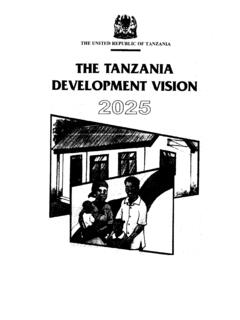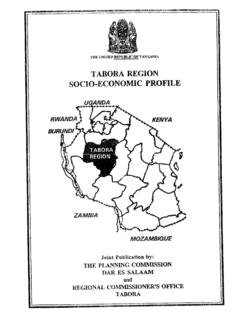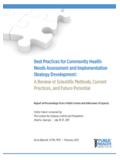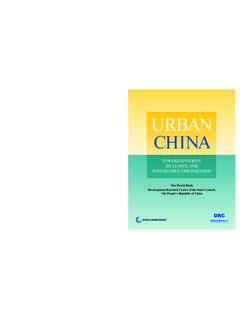Transcription of UNITED REPUBLIC OF TANZANIA PRIME MINISTER S OFFICE …
1 UNITED REPUBLIC OF TANZANIA . P RIME MINISTER ' S O FFICE. RURAL DE VELOPMENT STRAT EGY. MAIN RE PORT. FINAL. 19th December 2001. TABLE OF CONTENTS. LIST OF ABBREVIATIONS .. III. BACKGROUND ..1. DEFINITION OF RURAL AREAS .. 1. THE NEED FOR A RURAL development strategy ..1. THE POLICY CONTEXT OF THE RURAL development strategy (RDS) ..2. THE OVERALL OBJECTIVE OF THE RURAL development strategy .. 4. THE DIMENSIONS OF RURAL development strategy .. 6. CONSULTATION ORGANIZATION ..8. PREPARATION OF THE PERSPECTIVES OF V ARIOUS STAKEHOLDERS ..8. THE RURAL development INCOME GENERATING ACTIVITIES .. 11. INCREASING OPPORTUNITIES AND ACCESS TO SERVICES ..16. CROSS CUTTING I SSUES.
2 22. STRENGTHS, WEAKNESSES, OPPORTUNITIES , RISKS AND OVERVIEW OF THE THE strategy ..27. PROMOTING W IDELY SHARED GROWTH ..27. INCREASING OPPORTUNITIES AND ACCESS TO SERVICES ..51. REDUCING RISKS AND 67. GOOD 70. CO-ORDINATION OF THE RDS 78. MONITORING AND EVALUATION MONITORING PREPARATION AND REVIEW OF DISTRICT D EVELOPMENT P LANS .. 84. THE ROLE OF LINE 84. THE ROLE OF THE P RIVATE SECTOR AND CIVIL SOCIETY .. 84. _____ i Rural development strategy for TANZANIA : Final Draft: Main Report LIST OF ABBREVIATIONS. AIDS Acquired Immune Deficiency Syndrome ALAT Association of Local Authorities in TANZANIA ASDS Agriculture Sector development strategy CBAHW Community Based Animal Health Workers CBM Community Based Management CBO Community Based Organizations CMR Child Mortality Rate CMT Council Management Team COBET Complementary Basic Education in TANZANIA CSD Civil Service Department DC District Commissioner DEO District Education Officer DFZ Disease Free Zones EIA Environmental Impact Assessment FSD Food Security Department FY Financial Year GDP Gross Domestic Product GER Gross Enrolment Rate HBS Household Budget Survey HIPC Highly Indebted Poor Countries HIV Human
3 Immuno-deficiency Virus ICT Information and Communication Technology IMR Infant Mortality Rate IT Information Technology LGAs Local Government Authorities LGRP Local Government Reform Programme LPG Liquefied Petroleum Gas MAFS Ministry of Agriculture and Food Security MCDWAC Ministry of Community development Women Affairs and Children MCH Maternal Child Health MCM Ministry of Co-operatives and Marketing MEM Ministry of Energy and Minerals MFIS Micro Finance Institutions MIT Ministry Industry and Trade MJCA Ministry of Justice and Constitutional Affairs MLHSD Ministry of Lands and Human Settlements development MLYS Ministry of Labour, Youths and Sports MME Ministry of Minerals and Energy MMR Maternal Mortality Rate MMS Mobile Maintenance Systems MNRT Ministry of Natural Resources and Tourism MOEC Ministry of Education and Culture MOF Ministry Of Finance MOH Ministry of Health MOW Ministry of Works MSE Micro and Small-Scale Enterprises MSTHE Ministry of Science, Technology and Higher Education _____ ii Rural development strategy for TANZANIA : Final Draft.
4 Main Report MTC Ministry of Transport and Communications MTEF Medium Term Expenditure Framework MTP Multi-Sectoral Medium Term Plan MWLD Ministry of Water and Livestock development NACP National Aids Co-ordinating Programme NARCO National Ranching Company NEP National Employment Policy NER Net Enrolment Rate NGO Non Governmental Organisation NMC National Milling Corporation NPES National Poverty Eradication strategy NRDC National Rural development Council NTP National Telecommunication Policy PER Public Expenditure Review PHC Public Health Care PMO PRIME MINISTER 's OFFICE PO President's OFFICE PO-RALG President's OFFICE , Regional Administration and Local Government PO-PP President's OFFICE , Planning and Privatisation PRAS Protected Areas PRSP Poverty Reduction strategy Paper R&D Research and development RCC Regional Consultative Committee RD Rural development RDP Rural development Policy RDS Rural development strategy RFB Road Fund Board RMI Road Maintenance Initiative SADC Southern Africa development Community SGR Strategic Grain Reserve SIDP Sustainable Industrial development Policy SME Small and Medium Enterprises STDs Sexually Transmitted Diseases SWOT Strengths, Weaknesses, Opportunities and Threats TACAIDS TANZANIA Commission on AIDS.
5 TANROADS TANZANIA National Roads Agency TAS TANZANIA Assistance strategy TDV TANZANIA development Vision TFNC TANZANIA Food and Nutrition Centre TOT Terms of Trade TPC TANZANIA Posts Corporation TRHS TANZANIA Reproductive and Health Survey TRP Telecommunication Restructuring Programme TTCL TANZANIA Telecommunications Company Limited VET Vocational Education Training VETA Vocational Education Training Authority VPO Vice President's OFFICE VTCs Vocational Training Centre WEC Ward Education Co-ordinator WUAs Water Users Associations _____ iii Rural development strategy for TANZANIA : Final Draft: Main Report BACKGROUND. Definition of Rural Areas Rural development concerns geographical areas in which primary production takes place and where populations are found in varying densities.
6 These areas are characterised by activities related to primary and secondary processing, marketing and services that serve rural and urban populations. Therefore, rural development concerns a wide range of farm and non-farm activities. In order to achieve rural development the linkage between rural and close by small towns and urban centres is crucial. For Operationalisation of the RDS, therefore rural areas include villages and small towns/nearby urban centres. The Need for a Rural development strategy There are seven main reasons for the formulation of the rural development strategy . First, past Government polices and strategies failed to build up the necessary capacity that was needed to bring about a sustainable development in the rural areas.
7 The implementation of the various rural development strategies depended almost wholly on the Government. In the period 1961 to late 1970s the Government was able to expand and strengthen basic social services such as health and education. During that period TANZANIA made rapid socio- economic development and the country registered high social development indicators ni primary enrolments, literacy rates, health services, safe and clean water. However, by the mid 1980s these achievements could not be sustained. The heavy reliance on Government budgetary resources was untenable, and Government was unable to cope with the shocks that affected the economy. Second, the formulation of the rural development strategy relates to the fundamental structural reforms that have taken place during the last ten years or so.
8 The broad objective of these reforms has been to ensure macroeconomic stability and improve market efficiency. In addition, the public sector has, by and large, been reformed. As a result of these reforms, TANZANIA has progressed significantly in re-establishing macro-economic stability. Inflation has fallen from levels in excess of 30 percent in 1995 to in July 2001. Furthermore, the exchange rate has remained reasonably stable, the foreign exchange reserves position has climbed from about six weeks of merchandise imports in 1995 to the current level of 18. weeks, and; the overall fiscal balance, including grants, has had a surplus of between percent and percent of GDP.
9 However these macro economic achievements have not benefited the majority of Tanzanians, particularly those living in the rural areas. For macro- economic achievements to have significant impact on rural development fundamental strategic changes are needed in the rural economy. Third, the formulation of the rural development strategy arises from the unsatisfactory performance of the agricultural sector, the economic base of the rural areas. A wide range of policies and institutional reforms at the macro and sectoral levels since the 1980s have contributed to an increase in the growth rate of agricultural production; from percent in early 1980s to about 4 percent by the end of 1990s.
10 However this level of growth is too low to have any significant impact on rural development in general and on abject poverty in particular. The minimum growth rate required to reduce poverty is 6 percent. The performance of most food crops has remained poor, mainly due to extreme rainfall patterns and low technology used. As a result the food security situation has remained one of _____ 1. Rural development strategy for TANZANIA : Final Draft: Main Report the major problems in the rural areas. There is need to increase agricultural productivity by improving markets, private sector investment, physical infrastructure, human capital, and demand driven research and extension services.














